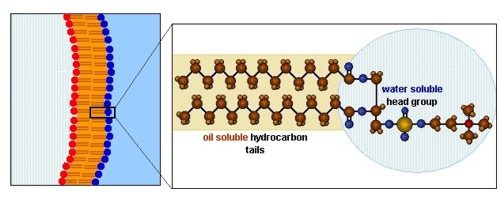David J. Neivandt
|
|
Professor 301 Jenness Hall
Office: 348 Ferland Phone: 207.581.2288 |
Research Interests
Determination of the orientation and conformation of interfacial species • surface spectroscopies/microscopies
Current Research
Determination of the Orientation and Conformation of Interfacial Species
- Characterization of adsorption from singular and binary polymer/surfactant solutions on industrially significant surfaces
- Development of model lipid membrane structures and investigation of deformations induced by adsorption/transport processes
- Investigation of potential sensing methodologies based on surface enhanced spectroscopies and molecular patterning
Surface Spectroscopies/Microscopies
- Application of the second order non-linear optical laser technique of Sum Frequency vibrational Spectroscopy (SFS) to provide structural information of interfacial species
- Incorporation of other complementary techniques giving surface excesses of adsorbed species and interfacial morphologies
Interfacial adsorption is of critical importance in many industrial and biological processes, primarily due to the fact that system properties such as flocculation, flotation and biological recognition may be modified by interaction with an interface of miniscule amounts of surface-active species such as polyelectrolytes (proteins) and surfactants (lipids). Whilst the surface excess of the adsorbate is often of importance in inducing behavioral change, structural properties such as the polar orientation and degree of conformational order are also critical. A great deal of research has been performed on quantifying the effect of variables such as concentration of the surface-active species, electrolyte concentration, pH and temperature on surface excess. Comparatively little work however has focused on determining the effect of the same system properties on the detailed structure of the adsorbed layer. The primary reason for this paucity of data is the lack of techniques capable of providing interface specific structural information.
The aim of our research is to determine detailed conformational informational of interfacial species in industrially and biologically relevant systems with the intention of gaining insight into how the surface structure affects the properties of the system. The primary technique employed is the surface specific second order non-linear optical technique of Sum Frequency vibrational Spectroscopy (SFS). This high energy laser technique involves overlapping, both spatially and temporally, a visible beam of fixed frequency and an infrared beam of tunable frequency on an interface. A third beam is emitted from the interface, the frequency of which is the sum of the two incident frequencies. Detecting this emitted light as function of the infrared wavelength produces a vibrational spectrum that is upshifted into the visible. The polar orientation of species resident at the interface is determined from the relative phase of the resonance signal, that is, whether ‘peaks’ or ‘dips’ are observed in the spectrum. Conformational information of the species is reflected by the relative strength of the resonance signals. A broadband femtosecond SF spectrometer is near completion in the group’s laser laboratory.
The detailed structural information of interfacial species obtained by SFS is complemented by information obtained by a range of other surface techniques in order to provide a more complete picture of the interface. Specifically, the surface excess of the adsorbate is determined by appropriate linear transmission or reflection spectroscopies, for example UV-visible transmission and infrared attenuated total reflection. Further, extensive use of Atomic Force Microscopy is made in order to associate the surface excess and structural information with interfacial topography. Current projects include: conformational studies of lipid molecules comprising model membranes and polymer templating in surfactant monolayers.
- Conformational Studies of Lipid Molecules Comprising Model Membranes
Biological membranes consist of a bilayer of primarily lipid molecules which contain a polar headgroup and two pendent hydrocarbon chains. The conformational structure of the alkyl chains of the lipid is known to influence membrane properties such as the rigidity, the degree of in-plane fluidity and trans membrane transport phenomena. However, detailed studies precisely characterising the structural effects of lipids on membrane properties are complicated by the difficulty of deconvoluting the complex native systems. Consequently there is a strong need for a model membrane system that accurately reproduces the characteristics of a native membrane and that may be studied by techniques that yield conformational information. This project aims to construct asymmetric membranes consisting of two different lipid molecules each in a separate layer of the bilayer. The degree of conformational order of the alkyl chains of the lipids will then be determined under a wide range of conditions by application of Sum Frequency vibrational Spectroscopy (SFS). Aspects of surface science, biological engineering, laser spectroscopy and equipment construction and development are involved in this project.

A schematic representation of an asymmetric biological membrane (left) composed of lipid molecules (right). The conformational structure (the number of gauche versus trans conformers) of the lipid alkyl chains affects the macroscopic membrane properties.
- Polymer Templating in Surfactant Monolayers
This project aims to develop an entirely new means of providing specificity in surface functionality via polymer templating in surfactant monolayers. Unlike the commonly used antibody/antigen approach, this technique will be applicable to a variety of charged polymers (biological or non) without the need for a specific complementary species. Indeed in principle even the detailed structural nature of the polymer itself need not necessarily be known. Further, the technique will circumvent the solvent and exposure of binding site issues of another common templating technique, molecular imprinting. Our group has previously demonstrated that electrostatically charged polymers remove oppositely charged surfactant molecules from densely packed surface bound surfactant monolayers. The result of this polymer/surfactant interaction is the formation of holes in the surfactant monolayer which, due to the stoichiometric nature of the polymer/surfactant interaction, replicate the shape and charge distribution of the polymer. This process is represented schematically below. Importantly we have recently shown that these holes are stable for time periods of the order of hours and that they may be stabilized indefinitely through covalent modification. Further, we have successfully functionalized the exposed substrate within the holes with charged sites which compliment those of the polymer. Current work is aimed at determining the extent to which the templates or ‘negatives’ of the polymer structure created display specificity for the polymer.

Selected Publications

